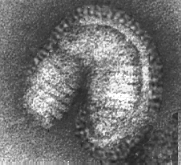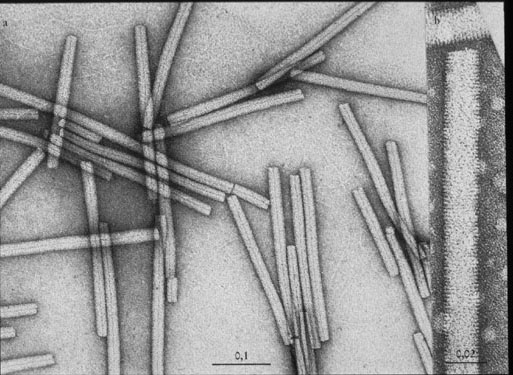|
The survival of the human
species is not a preordained evolutionary program. Abundant sources
of genetic variation exist for viruses to learn new tricks, not
necessarily confined to what happens routinely, or even frequently.
- Joshua Lederberg, Nobel
Laureate
|
|
Viruses are tiny macromolecular
structures that infect and incorporate their DNA or RNA into the
genome of a host cell in order to make replicas of themselves. Despite
their small size, viruses have been the cause of some of the world's
worst epidemics. The influenza epidemic of 1918 was the result of
more than 500,000 American deaths. More recently, HIV has become
a leading cause of death in the United States and elsewhere. Viruses,
however, are not only studied for their infectious nature but for
their use in understanding basic biology. The fast reproduction
rate combined with their small size make viruses a good model organism
for biologists studying molecular genetics.
|
,  |
| An
electron micrograph image of the the influenza virus, the cause of
the common cold. Image courtesy of Linda Stannard. |
|
|
The
discovery of viruses begins in 1883, when the German scientist, A.
Mayer, was searching for the cause of a disease that destroyed crops
of tobacco. The disease, known as tobacco mosiac disease was found
to spread from plant to plant despite being passed through a filter
designed to remove bacteria. Another scientist found evidence that
the microbe was not a bacteria because it could not be cultivated
on nutrient media, nor could ethanol, which is usually toxic to bacteria,
prevent the microbe of infecting more plants. Finally, in 1935 Wendell
Stanley crystallized the infectious agent, thus confirming the suspicions
of many scientists that there was another class of microbes exist
that were distinct from bacteria. |
| An electron microscope
image of the Tobacco Mosiac Virus (TMV). Image courtesy of Carl Wetter. |
| 1798 |
Edward Jenner
developed a smallpox vaccine |
| 1892 |
Dimitri I. Ivanovsk
discovered filterability of TMV |
| 1898 |
Friedrich Loeffler
and Paul Frosch discovered filterability of foot and mouth disease |
| 1901 |
Walter Reed discovered
yellow fever |
| 1909 |
S. Flexner and
P. Lewis discovered poliomylitis |
| 1911 |
J. Goldberger
and J. Anderson discovered measles |
| 1934 |
C. Johnson and
E. Goodpasture discovered the mumps virus |
| 1935 |
W. Stanley crystallized
TMV |
| 1939 |
G. Kausche, E.
Pfankuch, and H. Ruska used electron microscopy to visualize virus |
| 1953 |
J. Watson and
F. Crick proposed double- helix model of DNA |
|

